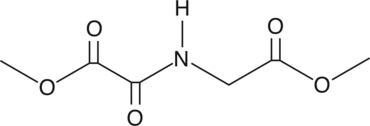Chemicals
Showing 17701–17850 of 41137 results
-
DL-α-Difluoromethylornithine (DFMO) is an irreversible inhibitor of ornithine decarboxylase that suppresses polyamine biosynthesis.{27553} DFMO displays antiangiogenic and cytostatic effects in tumor cells but must be used in combination with other chemotherapeutic agents to negate compensatory increases in polyamine content through alternate synthesis pathways.{27553,27552,27554,27555} Through inhibition of polyamine synthesis, DFMO also demonstrates antiparasitic activity in a model of C. parvum infection.{26876}
Brand:CaymanSKU:-Out of stock
DL-α-Lipoic acid is a cyclic disulfide antioxidant that interconverts with its reduced dithiol form. It is an essential cofactor for decarboxylation reactions of the citric acid cycle, and acts as a general antioxidant.{12280,12281,12322} DL-α-lipoic acid can act as a direct radical scavenger, as a cofactor to regenerate reduced glutathione, and as a metal chelator.
Brand:CaymanSKU:10005728 - 1 gAvailable on backorder
DL-α-Lipoic acid is a cyclic disulfide antioxidant that interconverts with its reduced dithiol form. It is an essential cofactor for decarboxylation reactions of the citric acid cycle, and acts as a general antioxidant.{12280,12281,12322} DL-α-lipoic acid can act as a direct radical scavenger, as a cofactor to regenerate reduced glutathione, and as a metal chelator.
Brand:CaymanSKU:10005728 - 10 gAvailable on backorder
DL-α-Lipoic acid is a cyclic disulfide antioxidant that interconverts with its reduced dithiol form. It is an essential cofactor for decarboxylation reactions of the citric acid cycle, and acts as a general antioxidant.{12280,12281,12322} DL-α-lipoic acid can act as a direct radical scavenger, as a cofactor to regenerate reduced glutathione, and as a metal chelator.
Brand:CaymanSKU:10005728 - 25 gAvailable on backorder
DL-α-Lipoic acid is a cyclic disulfide antioxidant that interconverts with its reduced dithiol form. It is an essential cofactor for decarboxylation reactions of the citric acid cycle, and acts as a general antioxidant.{12280,12281,12322} DL-α-lipoic acid can act as a direct radical scavenger, as a cofactor to regenerate reduced glutathione, and as a metal chelator.
Brand:CaymanSKU:10005728 - 5 gAvailable on backorder
DLAC is a detergent synthesized from lactobionic acid.{40970,40971} It can be used to solubilize membrane proteins and has a critical micelle concentration (CMC) of 1.3 mM.
Brand:CaymanSKU:24780 - 250 mgAvailable on backorder
N2′-deacetyl-N2′-[3-[[1-[[4-[[(2,5-dioxo-1-pyrrolidinyl)oxy]carbonyl]cyclohexyl]methyl]-2,5-dioxo-3-pyrrolidinyl]thio]-1-oxopropyl]-maytansine DM1-SMCC is a cleavable linker-based antibody-drug conjugate (ADC) containing the maytansinoid DM1 (mertansine; Item No. 22483) and the crosslinker SMCC.{35225,35224} ADCs target specific cell populations to induce a selective response, such as cell death in cancer cells. DM1-SMCC conjugated to an anti-CD70 antibody has been used to study the transport of the ADC catabolites into the cell cytoplasm of 786-0 renal cell carcinoma cells.
Brand:CaymanSKU:23926 - 1 mgAvailable on backorder
N2′-deacetyl-N2′-[3-[[1-[[4-[[(2,5-dioxo-1-pyrrolidinyl)oxy]carbonyl]cyclohexyl]methyl]-2,5-dioxo-3-pyrrolidinyl]thio]-1-oxopropyl]-maytansine DM1-SMCC is a cleavable linker-based antibody-drug conjugate (ADC) containing the maytansinoid DM1 (mertansine; Item No. 22483) and the crosslinker SMCC.{35225,35224} ADCs target specific cell populations to induce a selective response, such as cell death in cancer cells. DM1-SMCC conjugated to an anti-CD70 antibody has been used to study the transport of the ADC catabolites into the cell cytoplasm of 786-0 renal cell carcinoma cells.
Brand:CaymanSKU:23926 - 10 mgAvailable on backorder
N2′-deacetyl-N2′-[3-[[1-[[4-[[(2,5-dioxo-1-pyrrolidinyl)oxy]carbonyl]cyclohexyl]methyl]-2,5-dioxo-3-pyrrolidinyl]thio]-1-oxopropyl]-maytansine DM1-SMCC is a cleavable linker-based antibody-drug conjugate (ADC) containing the maytansinoid DM1 (mertansine; Item No. 22483) and the crosslinker SMCC.{35225,35224} ADCs target specific cell populations to induce a selective response, such as cell death in cancer cells. DM1-SMCC conjugated to an anti-CD70 antibody has been used to study the transport of the ADC catabolites into the cell cytoplasm of 786-0 renal cell carcinoma cells.
Brand:CaymanSKU:23926 - 25 mgAvailable on backorder
N2′-deacetyl-N2′-[3-[[1-[[4-[[(2,5-dioxo-1-pyrrolidinyl)oxy]carbonyl]cyclohexyl]methyl]-2,5-dioxo-3-pyrrolidinyl]thio]-1-oxopropyl]-maytansine DM1-SMCC is a cleavable linker-based antibody-drug conjugate (ADC) containing the maytansinoid DM1 (mertansine; Item No. 22483) and the crosslinker SMCC.{35225,35224} ADCs target specific cell populations to induce a selective response, such as cell death in cancer cells. DM1-SMCC conjugated to an anti-CD70 antibody has been used to study the transport of the ADC catabolites into the cell cytoplasm of 786-0 renal cell carcinoma cells.
Brand:CaymanSKU:23926 - 5 mgAvailable on backorder
DM1-SMe is an analog of mertansine (DM1; Item No. 22483) with a thiomethane cap attached to the sulfhydryl group.{40725} It has in vitro activity against the pediatric preclinical testing program (PPTP) panel of cancer cell lines with IC50 values of 0.002 to >3 nM.
Brand:CaymanSKU:22477 -Out of stock
DM1-SMe is an analog of mertansine (DM1; Item No. 22483) with a thiomethane cap attached to the sulfhydryl group.{40725} It has in vitro activity against the pediatric preclinical testing program (PPTP) panel of cancer cell lines with IC50 values of 0.002 to >3 nM.
Brand:CaymanSKU:22477 -Out of stock
DM1-SMe is an analog of mertansine (DM1; Item No. 22483) with a thiomethane cap attached to the sulfhydryl group.{40725} It has in vitro activity against the pediatric preclinical testing program (PPTP) panel of cancer cell lines with IC50 values of 0.002 to >3 nM.
Brand:CaymanSKU:22477 -Out of stock
DM1-SMe is an analog of mertansine (DM1; Item No. 22483) with a thiomethane cap attached to the sulfhydryl group.{40725} It has in vitro activity against the pediatric preclinical testing program (PPTP) panel of cancer cell lines with IC50 values of 0.002 to >3 nM.
Brand:CaymanSKU:22477 -Out of stock
DMA is a bisbenzimidazole radioprotective agent.{49648,49649} In vivo, DMA (300 mg/kg) decreases radiation-induced lethality without affecting radiation-induced tumor regression in an Ehrlich murine spontaneous adenocarcinoma model.{49648} It prevents radiation-induced damage of intestinal, hepatic, and splenic tissues, increases in splenic malondialdehyde (MDA) production, and decreases in splenic superoxide dismutase (SOD) activity in a B16/F10 murine melanoma model when administered at a dose of 50 mg/kg.{49649}
Brand:CaymanSKU:30416 - 1 mgAvailable on backorder
DMA is a bisbenzimidazole radioprotective agent.{49648,49649} In vivo, DMA (300 mg/kg) decreases radiation-induced lethality without affecting radiation-induced tumor regression in an Ehrlich murine spontaneous adenocarcinoma model.{49648} It prevents radiation-induced damage of intestinal, hepatic, and splenic tissues, increases in splenic malondialdehyde (MDA) production, and decreases in splenic superoxide dismutase (SOD) activity in a B16/F10 murine melanoma model when administered at a dose of 50 mg/kg.{49649}
Brand:CaymanSKU:30416 - 10 mgAvailable on backorder
DMA is a bisbenzimidazole radioprotective agent.{49648,49649} In vivo, DMA (300 mg/kg) decreases radiation-induced lethality without affecting radiation-induced tumor regression in an Ehrlich murine spontaneous adenocarcinoma model.{49648} It prevents radiation-induced damage of intestinal, hepatic, and splenic tissues, increases in splenic malondialdehyde (MDA) production, and decreases in splenic superoxide dismutase (SOD) activity in a B16/F10 murine melanoma model when administered at a dose of 50 mg/kg.{49649}
Brand:CaymanSKU:30416 - 5 mgAvailable on backorder
Phosphatidylethanolamine (PE) lipids are important components of cell membranes and biochemical pathways of fatty acid synthesis that contain abundant polyunsaturated fatty acyl (PUFA) groups. Oxidation of these phospholipids may be linked to various human diseases. DMABA NHS ester is a reagent that reacts with the primary amine group of PE lipids.{20256,20365} This facilitates the use of electrospray tandem mass spectrometry for the detection of diacyl, ether, and plasmalogen PE lipids that cannot be readily observed otherwise.{20256,20365} DMABA NHS ester has been used in combination with DMABA NHS ester-d4, -d6, and -d10 (Item Nos. 11217, 11218, and 11219) to study relative changes in PE lipid abundance before and after radical oxidation.{20365}
Brand:CaymanSKU:11216 - 100 mgAvailable on backorder
Phosphatidylethanolamine (PE) lipids are important components of cell membranes and biochemical pathways of fatty acid synthesis that contain abundant polyunsaturated fatty acyl (PUFA) groups. Oxidation of these phospholipids may be linked to various human diseases. DMABA NHS ester is a reagent that reacts with the primary amine group of PE lipids.{20256,20365} This facilitates the use of electrospray tandem mass spectrometry for the detection of diacyl, ether, and plasmalogen PE lipids that cannot be readily observed otherwise.{20256,20365} DMABA NHS ester has been used in combination with DMABA NHS ester-d4, -d6, and -d10 (Item Nos. 11217, 11218, and 11219) to study relative changes in PE lipid abundance before and after radical oxidation.{20365}
Brand:CaymanSKU:11216 - 50 mgAvailable on backorder
Phosphatidylethanolamine (PE) lipids are important components of cell membranes and biochemical pathways of fatty acid synthesis that contain abundant polyunsaturated fatty acyl (PUFA) groups. Oxidation of these phospholipids may be linked to various human diseases. DMABA NHS ester is a reagent that reacts with the primary amine group of PE lipids.{20256,20365} This facilitates the use of electrospray tandem mass spectrometry for the detection of diacyl, ether, and plasmalogen PE lipids that cannot be readily observed otherwise.{20256,20365} DMABA NHS ester has been used in combination with DMABA NHS ester-d4, -d6, and -d10 (Item Nos. 11217, 11218, and 11219) to study relative changes in PE lipid abundance before and after radical oxidation.{20365}
Brand:CaymanSKU:11216 - 500 mgAvailable on backorder
DMABA-d10 NHS ester is intended for use in combination with DMABA NHS ester (Item No. 11216) as a derivatizing reagent for PE lipids in order to facilitate MS characterization and to quantify relative changes in their abundance. DMABA-d10 and DMABA NHS esters have been shown to facilitate the characterization of PE lipids via electrospray mass spectrometry by providing a common precursor ion scan for diacyl, ether, and plasmalogen PE lipids.{20256} Furthermore, application of split-and-pool methodology allows for relative changes in endogenous PE lipid levels between control and treated samples to be measured.{20365} Phosphatidylethanolamine (PE) lipids are important components of cell membranes and biochemical pathways of fatty acid synthesis that contain abundant polyunsaturated fatty acyl groups. Oxidation of these phospholipids may be linked to various human diseases. DMABA NHS ester is a reagent that reacts with the primary amine group of PE lipids.{20256,20365} This facilitates the use of electrospray tandem mass spectrometry for the detection of diacyl, ether, and plasmalogen PE lipids that cannot be readily observed otherwise.{20256,20365}
Brand:CaymanSKU:11219 - 1 mgAvailable on backorder
DMABA-d10 NHS ester is intended for use in combination with DMABA NHS ester (Item No. 11216) as a derivatizing reagent for PE lipids in order to facilitate MS characterization and to quantify relative changes in their abundance. DMABA-d10 and DMABA NHS esters have been shown to facilitate the characterization of PE lipids via electrospray mass spectrometry by providing a common precursor ion scan for diacyl, ether, and plasmalogen PE lipids.{20256} Furthermore, application of split-and-pool methodology allows for relative changes in endogenous PE lipid levels between control and treated samples to be measured.{20365} Phosphatidylethanolamine (PE) lipids are important components of cell membranes and biochemical pathways of fatty acid synthesis that contain abundant polyunsaturated fatty acyl groups. Oxidation of these phospholipids may be linked to various human diseases. DMABA NHS ester is a reagent that reacts with the primary amine group of PE lipids.{20256,20365} This facilitates the use of electrospray tandem mass spectrometry for the detection of diacyl, ether, and plasmalogen PE lipids that cannot be readily observed otherwise.{20256,20365}
Brand:CaymanSKU:11219 - 10 mgAvailable on backorder
DMABA-d10 NHS ester is intended for use in combination with DMABA NHS ester (Item No. 11216) as a derivatizing reagent for PE lipids in order to facilitate MS characterization and to quantify relative changes in their abundance. DMABA-d10 and DMABA NHS esters have been shown to facilitate the characterization of PE lipids via electrospray mass spectrometry by providing a common precursor ion scan for diacyl, ether, and plasmalogen PE lipids.{20256} Furthermore, application of split-and-pool methodology allows for relative changes in endogenous PE lipid levels between control and treated samples to be measured.{20365} Phosphatidylethanolamine (PE) lipids are important components of cell membranes and biochemical pathways of fatty acid synthesis that contain abundant polyunsaturated fatty acyl groups. Oxidation of these phospholipids may be linked to various human diseases. DMABA NHS ester is a reagent that reacts with the primary amine group of PE lipids.{20256,20365} This facilitates the use of electrospray tandem mass spectrometry for the detection of diacyl, ether, and plasmalogen PE lipids that cannot be readily observed otherwise.{20256,20365}
Brand:CaymanSKU:11219 - 5 mgAvailable on backorder
DMABA-d4 NHS ester is intended for use in combination with DMABA NHS ester (Item No. 11216) as a derivatizing reagent for PE lipids in order to facilitate MS characterization and to quantify relative changes in their abundance. DMABA-d4 and DMABA NHS esters have been shown to facilitate the characterization of PE lipids via electrospray mass spectrometry by providing a common precursor ion scan for diacyl, ether, and plasmalogen PE lipids.{20256} Furthermore, application of split-and-pool methodology allows for relative changes in endogenous PE lipid levels between control and treated samples to be measured.{20365} Phosphatidylethanolamine (PE) lipids are important components of cell membranes and biochemical pathways of fatty acid synthesis that contain abundant polyunsaturated fatty acyl groups. Oxidation of these phospholipids may be linked to various human diseases. DMABA NHS ester is a reagent that reacts with the primary amine group of PE lipids.{20256,20365} This facilitates the use of electrospray tandem mass spectrometry for the detection of diacyl, ether, and plasmalogen PE lipids that cannot be readily observed otherwise.{20256,20365}
Brand:CaymanSKU:11217 - 1 mgAvailable on backorder
DMABA-d4 NHS ester is intended for use in combination with DMABA NHS ester (Item No. 11216) as a derivatizing reagent for PE lipids in order to facilitate MS characterization and to quantify relative changes in their abundance. DMABA-d4 and DMABA NHS esters have been shown to facilitate the characterization of PE lipids via electrospray mass spectrometry by providing a common precursor ion scan for diacyl, ether, and plasmalogen PE lipids.{20256} Furthermore, application of split-and-pool methodology allows for relative changes in endogenous PE lipid levels between control and treated samples to be measured.{20365} Phosphatidylethanolamine (PE) lipids are important components of cell membranes and biochemical pathways of fatty acid synthesis that contain abundant polyunsaturated fatty acyl groups. Oxidation of these phospholipids may be linked to various human diseases. DMABA NHS ester is a reagent that reacts with the primary amine group of PE lipids.{20256,20365} This facilitates the use of electrospray tandem mass spectrometry for the detection of diacyl, ether, and plasmalogen PE lipids that cannot be readily observed otherwise.{20256,20365}
Brand:CaymanSKU:11217 - 10 mgAvailable on backorder
DMABA-d4 NHS ester is intended for use in combination with DMABA NHS ester (Item No. 11216) as a derivatizing reagent for PE lipids in order to facilitate MS characterization and to quantify relative changes in their abundance. DMABA-d4 and DMABA NHS esters have been shown to facilitate the characterization of PE lipids via electrospray mass spectrometry by providing a common precursor ion scan for diacyl, ether, and plasmalogen PE lipids.{20256} Furthermore, application of split-and-pool methodology allows for relative changes in endogenous PE lipid levels between control and treated samples to be measured.{20365} Phosphatidylethanolamine (PE) lipids are important components of cell membranes and biochemical pathways of fatty acid synthesis that contain abundant polyunsaturated fatty acyl groups. Oxidation of these phospholipids may be linked to various human diseases. DMABA NHS ester is a reagent that reacts with the primary amine group of PE lipids.{20256,20365} This facilitates the use of electrospray tandem mass spectrometry for the detection of diacyl, ether, and plasmalogen PE lipids that cannot be readily observed otherwise.{20256,20365}
Brand:CaymanSKU:11217 - 5 mgAvailable on backorder
DMABA-d6 NHS ester is intended for use in combination with DMABA NHS ester (Item No. 11216) as a derivatizing reagent for PE lipids in order to facilitate MS characterization and to quantify relative changes in their abundance. DMABA-d6 and DMABA NHS esters have been shown to facilitate the characterization of PE lipids via electrospray mass spectrometry by providing a common precursor ion scan for diacyl, ether, and plasmalogen PE lipids.{20256} Furthermore, application of split-and-pool methodology allows for relative changes in endogenous PE lipid levels between control and treated samples to be measured.{20365} Phosphatidylethanolamine (PE) lipids are important components of cell membranes and biochemical pathways of fatty acid synthesis that contain abundant polyunsaturated fatty acyl groups. Oxidation of these phospholipids may be linked to various human diseases. DMABA NHS ester is a reagent that reacts with the primary amine group of PE lipids.{20256,20365} This facilitates the use of electrospray tandem mass spectrometry for the detection of diacyl, ether, and plasmalogen PE lipids that cannot be readily observed otherwise.{20256,20365}
Brand:CaymanSKU:11218 - 1 mgAvailable on backorder
DMABA-d6 NHS ester is intended for use in combination with DMABA NHS ester (Item No. 11216) as a derivatizing reagent for PE lipids in order to facilitate MS characterization and to quantify relative changes in their abundance. DMABA-d6 and DMABA NHS esters have been shown to facilitate the characterization of PE lipids via electrospray mass spectrometry by providing a common precursor ion scan for diacyl, ether, and plasmalogen PE lipids.{20256} Furthermore, application of split-and-pool methodology allows for relative changes in endogenous PE lipid levels between control and treated samples to be measured.{20365} Phosphatidylethanolamine (PE) lipids are important components of cell membranes and biochemical pathways of fatty acid synthesis that contain abundant polyunsaturated fatty acyl groups. Oxidation of these phospholipids may be linked to various human diseases. DMABA NHS ester is a reagent that reacts with the primary amine group of PE lipids.{20256,20365} This facilitates the use of electrospray tandem mass spectrometry for the detection of diacyl, ether, and plasmalogen PE lipids that cannot be readily observed otherwise.{20256,20365}
Brand:CaymanSKU:11218 - 10 mgAvailable on backorder
DMABA-d6 NHS ester is intended for use in combination with DMABA NHS ester (Item No. 11216) as a derivatizing reagent for PE lipids in order to facilitate MS characterization and to quantify relative changes in their abundance. DMABA-d6 and DMABA NHS esters have been shown to facilitate the characterization of PE lipids via electrospray mass spectrometry by providing a common precursor ion scan for diacyl, ether, and plasmalogen PE lipids.{20256} Furthermore, application of split-and-pool methodology allows for relative changes in endogenous PE lipid levels between control and treated samples to be measured.{20365} Phosphatidylethanolamine (PE) lipids are important components of cell membranes and biochemical pathways of fatty acid synthesis that contain abundant polyunsaturated fatty acyl groups. Oxidation of these phospholipids may be linked to various human diseases. DMABA NHS ester is a reagent that reacts with the primary amine group of PE lipids.{20256,20365} This facilitates the use of electrospray tandem mass spectrometry for the detection of diacyl, ether, and plasmalogen PE lipids that cannot be readily observed otherwise.{20256,20365}
Brand:CaymanSKU:11218 - 5 mgAvailable on backorder
Dimethylallyl pyrophosphate and isopentyl pyrophosphate undergo condensation to yield geranyl pyrophosphate, which undergoes condensation with a second molecule of isopentyl pyrophosphate to yield farnesyl pyrophosphate.{6606,6607} Farnesylation is essential for the function of a number of proteins involved in signal transduction.{5456,2640}
Brand:CaymanSKU:63180 - 1 mgAvailable on backorder
Dimethylallyl pyrophosphate and isopentyl pyrophosphate undergo condensation to yield geranyl pyrophosphate, which undergoes condensation with a second molecule of isopentyl pyrophosphate to yield farnesyl pyrophosphate.{6606,6607} Farnesylation is essential for the function of a number of proteins involved in signal transduction.{5456,2640}
Brand:CaymanSKU:63180 - 10 mgAvailable on backorder
Dimethylallyl pyrophosphate and isopentyl pyrophosphate undergo condensation to yield geranyl pyrophosphate, which undergoes condensation with a second molecule of isopentyl pyrophosphate to yield farnesyl pyrophosphate.{6606,6607} Farnesylation is essential for the function of a number of proteins involved in signal transduction.{5456,2640}
Brand:CaymanSKU:63180 - 5 mgAvailable on backorder
Dimethylallyl pyrophosphate and isopentyl pyrophosphate undergo condensation to yield geranyl pyrophosphate, which undergoes condensation with a second molecule of isopentyl pyrophosphate to yield farnesyl pyrophosphate.{6606,6607} Farnesylation is essential for the function of a number of proteins involved in signal transduction.{5456,2640}
Brand:CaymanSKU:63180 - 500 µgAvailable on backorder
DMAT is a cell-permeable inhibitor of casein kinase 2 (CK2; IC50 = 0.13 µM).{22896} It also inhibits Pim-1, Pim-3, HIPK2, and HIPK3 (IC50s = 0.15, 0.097, 0.37, and 0.59 µM, respectively).{22896} DMAT blocks cell growth and induces cell death in cancer cells, both in culture and in mouse xenografts.{33787,33788,33789}
Brand:CaymanSKU:21182 -Out of stock
DMAT is a cell-permeable inhibitor of casein kinase 2 (CK2; IC50 = 0.13 µM).{22896} It also inhibits Pim-1, Pim-3, HIPK2, and HIPK3 (IC50s = 0.15, 0.097, 0.37, and 0.59 µM, respectively).{22896} DMAT blocks cell growth and induces cell death in cancer cells, both in culture and in mouse xenografts.{33787,33788,33789}
Brand:CaymanSKU:21182 -Out of stock
DMAT is a cell-permeable inhibitor of casein kinase 2 (CK2; IC50 = 0.13 µM).{22896} It also inhibits Pim-1, Pim-3, HIPK2, and HIPK3 (IC50s = 0.15, 0.097, 0.37, and 0.59 µM, respectively).{22896} DMAT blocks cell growth and induces cell death in cancer cells, both in culture and in mouse xenografts.{33787,33788,33789}
Brand:CaymanSKU:21182 -Out of stock
DMAT is a cell-permeable inhibitor of casein kinase 2 (CK2; IC50 = 0.13 µM).{22896} It also inhibits Pim-1, Pim-3, HIPK2, and HIPK3 (IC50s = 0.15, 0.097, 0.37, and 0.59 µM, respectively).{22896} DMAT blocks cell growth and induces cell death in cancer cells, both in culture and in mouse xenografts.{33787,33788,33789}
Brand:CaymanSKU:21182 -Out of stock
Bone morphogenetic proteins (BMP) are secreted signaling proteins, many of which are involved in various developmental processes, in addition to bone formation.{23503} DMH1 is an analog of the non-selective BMP receptor inhibitor dorsomorphin (Item No. 11967) that potently inhibits the kinase activity of activin receptor-like kinase 2 (ALK2; IC50 = 13-108 nM).{28912,28826} It is much less effective at ALK4, ALK5, AMPK, KDR (VEGFR2) or PDGFRβ, although it inhibits ALK1 and ALK3 at nanomolar concentrations.{28912,28826} DMH1 is effective in vivo, as it disrupts dorsoventral development in zebrafish.{28912} It also affects stem cell development, increasing cardiomyocyte progenitors and promoting neurogenesis.{28911,28914} DMH1 inhibits the growth of lung cancer cells, reducing tumor growth in a xenograft mouse model.{28913}
Brand:CaymanSKU:-Out of stock
Bone morphogenetic proteins (BMP) are secreted signaling proteins, many of which are involved in various developmental processes, in addition to bone formation.{23503} DMH1 is an analog of the non-selective BMP receptor inhibitor dorsomorphin (Item No. 11967) that potently inhibits the kinase activity of activin receptor-like kinase 2 (ALK2; IC50 = 13-108 nM).{28912,28826} It is much less effective at ALK4, ALK5, AMPK, KDR (VEGFR2) or PDGFRβ, although it inhibits ALK1 and ALK3 at nanomolar concentrations.{28912,28826} DMH1 is effective in vivo, as it disrupts dorsoventral development in zebrafish.{28912} It also affects stem cell development, increasing cardiomyocyte progenitors and promoting neurogenesis.{28911,28914} DMH1 inhibits the growth of lung cancer cells, reducing tumor growth in a xenograft mouse model.{28913}
Brand:CaymanSKU:-Out of stock
Bone morphogenetic proteins (BMP) are secreted signaling proteins, many of which are involved in various developmental processes, in addition to bone formation.{23503} DMH1 is an analog of the non-selective BMP receptor inhibitor dorsomorphin (Item No. 11967) that potently inhibits the kinase activity of activin receptor-like kinase 2 (ALK2; IC50 = 13-108 nM).{28912,28826} It is much less effective at ALK4, ALK5, AMPK, KDR (VEGFR2) or PDGFRβ, although it inhibits ALK1 and ALK3 at nanomolar concentrations.{28912,28826} DMH1 is effective in vivo, as it disrupts dorsoventral development in zebrafish.{28912} It also affects stem cell development, increasing cardiomyocyte progenitors and promoting neurogenesis.{28911,28914} DMH1 inhibits the growth of lung cancer cells, reducing tumor growth in a xenograft mouse model.{28913}
Brand:CaymanSKU:-Out of stock
Bone morphogenetic proteins (BMP) are secreted signaling proteins, many of which are involved in various developmental processes, in addition to bone formation.{23503} DMH1 is an analog of the non-selective BMP receptor inhibitor dorsomorphin (Item No. 11967) that potently inhibits the kinase activity of activin receptor-like kinase 2 (ALK2; IC50 = 13-108 nM).{28912,28826} It is much less effective at ALK4, ALK5, AMPK, KDR (VEGFR2) or PDGFRβ, although it inhibits ALK1 and ALK3 at nanomolar concentrations.{28912,28826} DMH1 is effective in vivo, as it disrupts dorsoventral development in zebrafish.{28912} It also affects stem cell development, increasing cardiomyocyte progenitors and promoting neurogenesis.{28911,28914} DMH1 inhibits the growth of lung cancer cells, reducing tumor growth in a xenograft mouse model.{28913}
Brand:CaymanSKU:-Out of stock
DMH4 is an inhibitor of VEGF receptor 2 (VEGFR2; IC50 = 0.16 µM in a cell-free assay) and a derivative of dorsomorphin (Item No. 11967).{28912} It selectively inhibits VEGFR2 over activin receptor-like kinase 2 (ALK2), ALK5, and AMPK (IC50s = 3.5, >30, and 8 µM, respectively, in a cell-free assay). DMH4 inhibits growth of H460 and A549 human lung cancer cells (GI50s = 13.3 and 2.8 µM, respectively) and reduces VEGF-induced tubule formation in human umbilical vein endothelial cells (HUVECs; IC50 = 1 µM).{28912,53048}
Brand:CaymanSKU:27653 - 1 mgAvailable on backorder
DMH4 is an inhibitor of VEGF receptor 2 (VEGFR2; IC50 = 0.16 µM in a cell-free assay) and a derivative of dorsomorphin (Item No. 11967).{28912} It selectively inhibits VEGFR2 over activin receptor-like kinase 2 (ALK2), ALK5, and AMPK (IC50s = 3.5, >30, and 8 µM, respectively, in a cell-free assay). DMH4 inhibits growth of H460 and A549 human lung cancer cells (GI50s = 13.3 and 2.8 µM, respectively) and reduces VEGF-induced tubule formation in human umbilical vein endothelial cells (HUVECs; IC50 = 1 µM).{28912,53048}
Brand:CaymanSKU:27653 - 10 mgAvailable on backorder
DMH4 is an inhibitor of VEGF receptor 2 (VEGFR2; IC50 = 0.16 µM in a cell-free assay) and a derivative of dorsomorphin (Item No. 11967).{28912} It selectively inhibits VEGFR2 over activin receptor-like kinase 2 (ALK2), ALK5, and AMPK (IC50s = 3.5, >30, and 8 µM, respectively, in a cell-free assay). DMH4 inhibits growth of H460 and A549 human lung cancer cells (GI50s = 13.3 and 2.8 µM, respectively) and reduces VEGF-induced tubule formation in human umbilical vein endothelial cells (HUVECs; IC50 = 1 µM).{28912,53048}
Brand:CaymanSKU:27653 - 25 mgAvailable on backorder
DMH4 is an inhibitor of VEGF receptor 2 (VEGFR2; IC50 = 0.16 µM in a cell-free assay) and a derivative of dorsomorphin (Item No. 11967).{28912} It selectively inhibits VEGFR2 over activin receptor-like kinase 2 (ALK2), ALK5, and AMPK (IC50s = 3.5, >30, and 8 µM, respectively, in a cell-free assay). DMH4 inhibits growth of H460 and A549 human lung cancer cells (GI50s = 13.3 and 2.8 µM, respectively) and reduces VEGF-induced tubule formation in human umbilical vein endothelial cells (HUVECs; IC50 = 1 µM).{28912,53048}
Brand:CaymanSKU:27653 - 5 mgAvailable on backorder
DMHAPC-Chol is a cationic cholesterol.{47185} Liposomes containing DMHAPC-chol have been used for DNA plasmid delivery in vitro and in vivo in a B16-F10 mouse xenograft model. Liposomes containing DMHAPC-chol are cytotoxic to B16-F10 cells when used at lipid concentrations greater than 20 µM. DMHAPC-Chol, as part of a lipoplex with DOPE (Item No. 15091), has also been used to deliver DNA into mouse lung via intratracheal injection, resulting in a heterogeneous distribution in the bronchi and bronchioles, and to deliver VEGF siRNA into A431 and MDA-MB-231 cells, which secrete VEGF.{47186,47187}
Brand:CaymanSKU:26582 - 1 mgAvailable on backorder
DMHAPC-Chol is a cationic cholesterol.{47185} Liposomes containing DMHAPC-chol have been used for DNA plasmid delivery in vitro and in vivo in a B16-F10 mouse xenograft model. Liposomes containing DMHAPC-chol are cytotoxic to B16-F10 cells when used at lipid concentrations greater than 20 µM. DMHAPC-Chol, as part of a lipoplex with DOPE (Item No. 15091), has also been used to deliver DNA into mouse lung via intratracheal injection, resulting in a heterogeneous distribution in the bronchi and bronchioles, and to deliver VEGF siRNA into A431 and MDA-MB-231 cells, which secrete VEGF.{47186,47187}
Brand:CaymanSKU:26582 - 10 mgAvailable on backorder
DMHAPC-Chol is a cationic cholesterol.{47185} Liposomes containing DMHAPC-chol have been used for DNA plasmid delivery in vitro and in vivo in a B16-F10 mouse xenograft model. Liposomes containing DMHAPC-chol are cytotoxic to B16-F10 cells when used at lipid concentrations greater than 20 µM. DMHAPC-Chol, as part of a lipoplex with DOPE (Item No. 15091), has also been used to deliver DNA into mouse lung via intratracheal injection, resulting in a heterogeneous distribution in the bronchi and bronchioles, and to deliver VEGF siRNA into A431 and MDA-MB-231 cells, which secrete VEGF.{47186,47187}
Brand:CaymanSKU:26582 - 25 mgAvailable on backorder
DMHAPC-Chol is a cationic cholesterol.{47185} Liposomes containing DMHAPC-chol have been used for DNA plasmid delivery in vitro and in vivo in a B16-F10 mouse xenograft model. Liposomes containing DMHAPC-chol are cytotoxic to B16-F10 cells when used at lipid concentrations greater than 20 µM. DMHAPC-Chol, as part of a lipoplex with DOPE (Item No. 15091), has also been used to deliver DNA into mouse lung via intratracheal injection, resulting in a heterogeneous distribution in the bronchi and bronchioles, and to deliver VEGF siRNA into A431 and MDA-MB-231 cells, which secrete VEGF.{47186,47187}
Brand:CaymanSKU:26582 - 5 mgAvailable on backorder
DMNQ is a 1,4-naphthoquinone that acts as a redox-cycling agent, typically increasing intracellular superoxide and hydrogen peroxide formation.{31226,31225,31227} The amount of oxidative stress is proportional to the amount of DMNQ applied and can alter diverse cellular parameters, including signal transduction, mitochondrial function, and gene expression.{31227,28824,31224}
Brand:CaymanSKU:-Available on backorder
DMNQ is a 1,4-naphthoquinone that acts as a redox-cycling agent, typically increasing intracellular superoxide and hydrogen peroxide formation.{31226,31225,31227} The amount of oxidative stress is proportional to the amount of DMNQ applied and can alter diverse cellular parameters, including signal transduction, mitochondrial function, and gene expression.{31227,28824,31224}
Brand:CaymanSKU:19571 -Available on backorder
DMNQ is a 1,4-naphthoquinone that acts as a redox-cycling agent, typically increasing intracellular superoxide and hydrogen peroxide formation.{31226,31225,31227} The amount of oxidative stress is proportional to the amount of DMNQ applied and can alter diverse cellular parameters, including signal transduction, mitochondrial function, and gene expression.{31227,28824,31224}
Brand:CaymanSKU:19571 -Available on backorder
DMNQ is a 1,4-naphthoquinone that acts as a redox-cycling agent, typically increasing intracellular superoxide and hydrogen peroxide formation.{31226,31225,31227} The amount of oxidative stress is proportional to the amount of DMNQ applied and can alter diverse cellular parameters, including signal transduction, mitochondrial function, and gene expression.{31227,28824,31224}
Brand:CaymanSKU:19571 -Available on backorder
The pro-angiogenic factor HIF-1α is targeted for destruction in normoxic environments by the hydroxylation of a specific proline residue, P564, by the oxygen-sensing enzyme HIF-1α prolyl hydroxylase (HIF-PH).{8840} DMOG is a cell permeable, competitive inhibitor of HIF-PH. It acts to stabilize HIF-1α expression at normal oxygen tensions in cultured cells, at concentrations between 0.1 and 1 mM.{8840} DMOG is therefore expected to act as a pro-angiogenic compound, acting via the HIF-1α system.{9790,8799}
Brand:CaymanSKU:71210 - 10 mgAvailable on backorder
The pro-angiogenic factor HIF-1α is targeted for destruction in normoxic environments by the hydroxylation of a specific proline residue, P564, by the oxygen-sensing enzyme HIF-1α prolyl hydroxylase (HIF-PH).{8840} DMOG is a cell permeable, competitive inhibitor of HIF-PH. It acts to stabilize HIF-1α expression at normal oxygen tensions in cultured cells, at concentrations between 0.1 and 1 mM.{8840} DMOG is therefore expected to act as a pro-angiogenic compound, acting via the HIF-1α system.{9790,8799}
Brand:CaymanSKU:71210 - 100 mgAvailable on backorder
The pro-angiogenic factor HIF-1α is targeted for destruction in normoxic environments by the hydroxylation of a specific proline residue, P564, by the oxygen-sensing enzyme HIF-1α prolyl hydroxylase (HIF-PH).{8840} DMOG is a cell permeable, competitive inhibitor of HIF-PH. It acts to stabilize HIF-1α expression at normal oxygen tensions in cultured cells, at concentrations between 0.1 and 1 mM.{8840} DMOG is therefore expected to act as a pro-angiogenic compound, acting via the HIF-1α system.{9790,8799}
Brand:CaymanSKU:71210 - 50 mgAvailable on backorder
The pro-angiogenic factor HIF-1α is targeted for destruction in normoxic environments by the hydroxylation of a specific proline residue, P564, by the oxygen-sensing enzyme HIF-1α prolyl hydroxylase (HIF-PH).{8840} DMOG is a cell permeable, competitive inhibitor of HIF-PH. It acts to stabilize HIF-1α expression at normal oxygen tensions in cultured cells, at concentrations between 0.1 and 1 mM.{8840} DMOG is therefore expected to act as a pro-angiogenic compound, acting via the HIF-1α system.{9790,8799}
Brand:CaymanSKU:71210 - 500 mgAvailable on backorder
DMPAC-Chol is a cationic cholesterol derivative that has been used in liposome formation for gene transfection.{42611} Liposomes containing DMPAC-chol bind to DNA in a band shift assay and protect against serum nuclease degradation of DNA when used at lipsome:DNA ratios ranging from 2.5:1 to 10:1 w/w. DMPAC-Chol-containing liposomes also reduce viability of HepG2 cells by 63% when used at a concentration of 37.5 µg/ml.
Brand:CaymanSKU:26583 - 1 mgAvailable on backorder
DMPAC-Chol is a cationic cholesterol derivative that has been used in liposome formation for gene transfection.{42611} Liposomes containing DMPAC-chol bind to DNA in a band shift assay and protect against serum nuclease degradation of DNA when used at lipsome:DNA ratios ranging from 2.5:1 to 10:1 w/w. DMPAC-Chol-containing liposomes also reduce viability of HepG2 cells by 63% when used at a concentration of 37.5 µg/ml.
Brand:CaymanSKU:26583 - 10 mgAvailable on backorder
DMPAC-Chol is a cationic cholesterol derivative that has been used in liposome formation for gene transfection.{42611} Liposomes containing DMPAC-chol bind to DNA in a band shift assay and protect against serum nuclease degradation of DNA when used at lipsome:DNA ratios ranging from 2.5:1 to 10:1 w/w. DMPAC-Chol-containing liposomes also reduce viability of HepG2 cells by 63% when used at a concentration of 37.5 µg/ml.
Brand:CaymanSKU:26583 - 5 mgAvailable on backorder
Free radicals are highly reactive, short-lived species. Spin traps react with radicals, forming stable adducts that can be further studied. DMPO is a commonly-used spin trap that reacts with O-, N-, S-, and C-centered radicals.{2717,10527,3851} This allows their characterization when used in association with electron spin resonance and immuno-spin trapping.{12375,12380,12293} DMPO is water-soluble, rapidly penetrates lipid bilayers, has low toxicity, and can be used in vitro and in vivo.{17434,9996,4914}
Brand:CaymanSKU:10006436 - 1 gAvailable on backorder
Free radicals are highly reactive, short-lived species. Spin traps react with radicals, forming stable adducts that can be further studied. DMPO is a commonly-used spin trap that reacts with O-, N-, S-, and C-centered radicals.{2717,10527,3851} This allows their characterization when used in association with electron spin resonance and immuno-spin trapping.{12375,12380,12293} DMPO is water-soluble, rapidly penetrates lipid bilayers, has low toxicity, and can be used in vitro and in vivo.{17434,9996,4914}
Brand:CaymanSKU:10006436 - 5 gAvailable on backorder
Free radicals are highly reactive, short-lived species. Spin traps react with radicals, forming stable adducts that can be further studied. DMPO is a commonly-used spin trap that reacts with O-, N-, S-, and C-centered radicals.{2717,10527,3851} This allows their characterization when used in association with electron spin resonance and immuno-spin trapping.{12375,12380,12293} DMPO is water-soluble, rapidly penetrates lipid bilayers, has low toxicity, and can be used in vitro and in vivo.{17434,9996,4914}
Brand:CaymanSKU:10006436 - 500 mgAvailable on backorder
DMPQ is a potent inhibitor of human platelet-derived growth factor receptor β (PDGFRβ, IC50 = 80 nM).{28580} It displays greater than 100-fold selectivity for PDGFRβ over other tyrosine and serine/threonine kinases.{28580} DMPQ effectively blocks the PDGF-mediated increase in the protein, Survival Motor Neuron, in fibroblasts from patients with spinal muscular atrophy.{22494}
Brand:CaymanSKU:-Available on backorder
DMPQ is a potent inhibitor of human platelet-derived growth factor receptor β (PDGFRβ, IC50 = 80 nM).{28580} It displays greater than 100-fold selectivity for PDGFRβ over other tyrosine and serine/threonine kinases.{28580} DMPQ effectively blocks the PDGF-mediated increase in the protein, Survival Motor Neuron, in fibroblasts from patients with spinal muscular atrophy.{22494}
Brand:CaymanSKU:-Available on backorder
DMPQ is a potent inhibitor of human platelet-derived growth factor receptor β (PDGFRβ, IC50 = 80 nM).{28580} It displays greater than 100-fold selectivity for PDGFRβ over other tyrosine and serine/threonine kinases.{28580} DMPQ effectively blocks the PDGF-mediated increase in the protein, Survival Motor Neuron, in fibroblasts from patients with spinal muscular atrophy.{22494}
Brand:CaymanSKU:-Available on backorder
DMXAA is a xanthene which acts as a tumor vascular disrupting agent, inducing apoptosis in tumor vascular endothelium resulting in necrosis at the tumor core.{23255,23259} It potently activates the TANK-binding kinase 1-interferon regulatory factor 3 (TBK1/IRF3) signaling pathway in leukocytes, inducing type-I-interferon (IFN) production.{23257,23258,23260} Specifically, DMXAA activates the mitochondria- and endoplasmic reticulum-associated protein known as stimulator of interferon genes (STING), leading to TBK1/IRF3 signaling.{28933} DMXAA signals through mouse STING but not human STING.{28932} In addition, DMXAA significantly inhibits several kinases in endothelial cells, including the vascular endothelial growth factor (VEGF) receptors VEGFR1 and VEGFR2 (IC50 = 119 and 11 µM, respectively).{23261}
Brand:CaymanSKU:-DMXAA is a xanthene which acts as a tumor vascular disrupting agent, inducing apoptosis in tumor vascular endothelium resulting in necrosis at the tumor core.{23255,23259} It potently activates the TANK-binding kinase 1-interferon regulatory factor 3 (TBK1/IRF3) signaling pathway in leukocytes, inducing type-I-interferon (IFN) production.{23257,23258,23260} Specifically, DMXAA activates the mitochondria- and endoplasmic reticulum-associated protein known as stimulator of interferon genes (STING), leading to TBK1/IRF3 signaling.{28933} DMXAA signals through mouse STING but not human STING.{28932} In addition, DMXAA significantly inhibits several kinases in endothelial cells, including the vascular endothelial growth factor (VEGF) receptors VEGFR1 and VEGFR2 (IC50 = 119 and 11 µM, respectively).{23261}
Brand:CaymanSKU:-DMXAA is a xanthene which acts as a tumor vascular disrupting agent, inducing apoptosis in tumor vascular endothelium resulting in necrosis at the tumor core.{23255,23259} It potently activates the TANK-binding kinase 1-interferon regulatory factor 3 (TBK1/IRF3) signaling pathway in leukocytes, inducing type-I-interferon (IFN) production.{23257,23258,23260} Specifically, DMXAA activates the mitochondria- and endoplasmic reticulum-associated protein known as stimulator of interferon genes (STING), leading to TBK1/IRF3 signaling.{28933} DMXAA signals through mouse STING but not human STING.{28932} In addition, DMXAA significantly inhibits several kinases in endothelial cells, including the vascular endothelial growth factor (VEGF) receptors VEGFR1 and VEGFR2 (IC50 = 119 and 11 µM, respectively).{23261}
Brand:CaymanSKU:-DMXAA is a xanthene which acts as a tumor vascular disrupting agent, inducing apoptosis in tumor vascular endothelium resulting in necrosis at the tumor core.{23255,23259} It potently activates the TANK-binding kinase 1-interferon regulatory factor 3 (TBK1/IRF3) signaling pathway in leukocytes, inducing type-I-interferon (IFN) production.{23257,23258,23260} Specifically, DMXAA activates the mitochondria- and endoplasmic reticulum-associated protein known as stimulator of interferon genes (STING), leading to TBK1/IRF3 signaling.{28933} DMXAA signals through mouse STING but not human STING.{28932} In addition, DMXAA significantly inhibits several kinases in endothelial cells, including the vascular endothelial growth factor (VEGF) receptors VEGFR1 and VEGFR2 (IC50 = 119 and 11 µM, respectively).{23261}
Brand:CaymanSKU:-Apurinic/apyrimidinic endonuclease-1 (Ape-1) is involved in base excision repair, cleaving the phosphodiester linkage that is 5’ to the abasic site to produce a single strand break.{26694} DNA base excision repair pathway inhibitor is a cell-permeable inhibitor of Ape-1 (IC50 = 3-11 µM).{26694,26697,26696} Although not toxic to cells by itself at 200 µM, it enhances the cytotoxicity of certain DNA alkylating agents, including temozolomide, when added at this concentration.{26697} DNA base excision repair pathway inhibitor has little or no effect on radiation-induced cell survival.{26697,26695}
Brand:CaymanSKU:-Out of stock
Apurinic/apyrimidinic endonuclease-1 (Ape-1) is involved in base excision repair, cleaving the phosphodiester linkage that is 5’ to the abasic site to produce a single strand break.{26694} DNA base excision repair pathway inhibitor is a cell-permeable inhibitor of Ape-1 (IC50 = 3-11 µM).{26694,26697,26696} Although not toxic to cells by itself at 200 µM, it enhances the cytotoxicity of certain DNA alkylating agents, including temozolomide, when added at this concentration.{26697} DNA base excision repair pathway inhibitor has little or no effect on radiation-induced cell survival.{26697,26695}
Brand:CaymanSKU:-Out of stock
Apurinic/apyrimidinic endonuclease-1 (Ape-1) is involved in base excision repair, cleaving the phosphodiester linkage that is 5’ to the abasic site to produce a single strand break.{26694} DNA base excision repair pathway inhibitor is a cell-permeable inhibitor of Ape-1 (IC50 = 3-11 µM).{26694,26697,26696} Although not toxic to cells by itself at 200 µM, it enhances the cytotoxicity of certain DNA alkylating agents, including temozolomide, when added at this concentration.{26697} DNA base excision repair pathway inhibitor has little or no effect on radiation-induced cell survival.{26697,26695}
Brand:CaymanSKU:-Out of stock
Apurinic/apyrimidinic endonuclease-1 (Ape-1) is involved in base excision repair, cleaving the phosphodiester linkage that is 5’ to the abasic site to produce a single strand break.{26694} DNA base excision repair pathway inhibitor is a cell-permeable inhibitor of Ape-1 (IC50 = 3-11 µM).{26694,26697,26696} Although not toxic to cells by itself at 200 µM, it enhances the cytotoxicity of certain DNA alkylating agents, including temozolomide, when added at this concentration.{26697} DNA base excision repair pathway inhibitor has little or no effect on radiation-induced cell survival.{26697,26695}
Brand:CaymanSKU:-Out of stock
DNA-PK inhibitor IV is an inhibitor of DNA-dependent protein kinase (DNA-PK) with an IC50 value of 400 nM for the DNA-PK-dependent phosphorylation of a p53 peptide substrate.{36586} It also inhibits the phosphatidylinositol 3-kinase (PI3K) isoforms p110β, p110δ, and p110γ (IC50s = 2.8, 5.1, and 37 nM, respectively) but not p110α (IC50 = ~10 µM) or class II PI3Ks, PI4Kβ, ATM, ATR, mTOR, CK2, or GRK2 (IC50s = >50 µM).{36587} It enhances radiation-induced cytotoxicity of HCT116 cells when used at a concentration of 100 µM.{36586}
Brand:CaymanSKU:24304 - 10 mgAvailable on backorder
DNA-PK inhibitor IV is an inhibitor of DNA-dependent protein kinase (DNA-PK) with an IC50 value of 400 nM for the DNA-PK-dependent phosphorylation of a p53 peptide substrate.{36586} It also inhibits the phosphatidylinositol 3-kinase (PI3K) isoforms p110β, p110δ, and p110γ (IC50s = 2.8, 5.1, and 37 nM, respectively) but not p110α (IC50 = ~10 µM) or class II PI3Ks, PI4Kβ, ATM, ATR, mTOR, CK2, or GRK2 (IC50s = >50 µM).{36587} It enhances radiation-induced cytotoxicity of HCT116 cells when used at a concentration of 100 µM.{36586}
Brand:CaymanSKU:24304 - 25 mgAvailable on backorder
DNA-PK inhibitor IV is an inhibitor of DNA-dependent protein kinase (DNA-PK) with an IC50 value of 400 nM for the DNA-PK-dependent phosphorylation of a p53 peptide substrate.{36586} It also inhibits the phosphatidylinositol 3-kinase (PI3K) isoforms p110β, p110δ, and p110γ (IC50s = 2.8, 5.1, and 37 nM, respectively) but not p110α (IC50 = ~10 µM) or class II PI3Ks, PI4Kβ, ATM, ATR, mTOR, CK2, or GRK2 (IC50s = >50 µM).{36587} It enhances radiation-induced cytotoxicity of HCT116 cells when used at a concentration of 100 µM.{36586}
Brand:CaymanSKU:24304 - 50 mgAvailable on backorder
DNP-INT is a quinone analog that inhibits electron transport in plants by competitively inhibiting plastoquinol oxidation by binding at the Qo site of cytochrome b6f (Kd = 1.4 nM).{40283} It inhibits electron flow from water to NADP or methylviologen by 50 and 100% when used at concentrations of 0.5 or 5 µM, respectively.{40281,40282}
Brand:CaymanSKU:9003061 - 1 mgAvailable on backorder
DNP-INT is a quinone analog that inhibits electron transport in plants by competitively inhibiting plastoquinol oxidation by binding at the Qo site of cytochrome b6f (Kd = 1.4 nM).{40283} It inhibits electron flow from water to NADP or methylviologen by 50 and 100% when used at concentrations of 0.5 or 5 µM, respectively.{40281,40282}
Brand:CaymanSKU:9003061 - 10 mgAvailable on backorder
DNP-INT is a quinone analog that inhibits electron transport in plants by competitively inhibiting plastoquinol oxidation by binding at the Qo site of cytochrome b6f (Kd = 1.4 nM).{40283} It inhibits electron flow from water to NADP or methylviologen by 50 and 100% when used at concentrations of 0.5 or 5 µM, respectively.{40281,40282}
Brand:CaymanSKU:9003061 - 25 mgAvailable on backorder
DNP-INT is a quinone analog that inhibits electron transport in plants by competitively inhibiting plastoquinol oxidation by binding at the Qo site of cytochrome b6f (Kd = 1.4 nM).{40283} It inhibits electron flow from water to NADP or methylviologen by 50 and 100% when used at concentrations of 0.5 or 5 µM, respectively.{40281,40282}
Brand:CaymanSKU:9003061 - 5 mgAvailable on backorder























